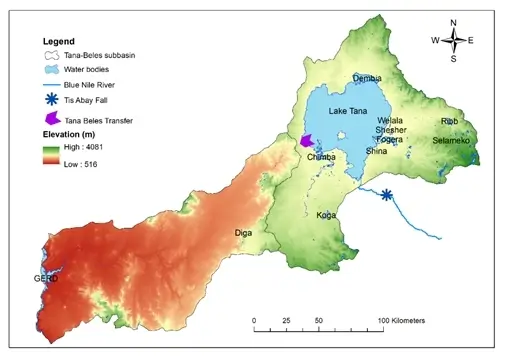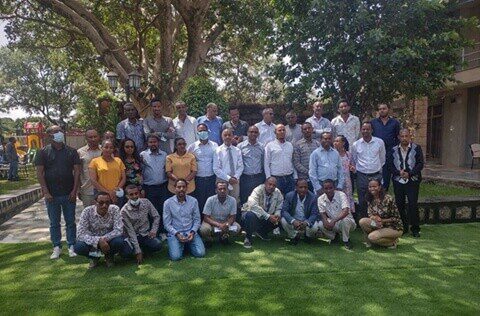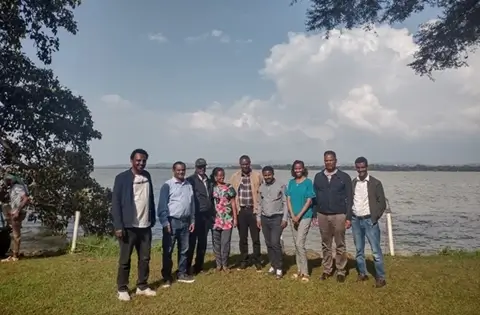International Water Management Institute (IWMI)
By Meron Teferi Taye, Girma Yimer Ebrahim, Jonathan Lautze and Abdulkarim Seid, IWMI

Lake Tana is the largest lake in Ethiopia and the source of the Blue Nile. Since 2010, an inter-basin water transfer project has delivered water from Lake Tana to the Beles River, itself a tributary of the Blue Nile. The Tana-Beles sub-basin has been developed by the Government of Ethiopia as an economic growth corridor for irrigation and energy development. Natural and built water storage in the sub-basin support fishing, irrigation, hydropower generation, drinking water supply, tourism and transportation, providing livelihoods and benefits for many people.
Achieving water, energy and food security while maintaining ecosystem health and associated benefits from tourism are goals that are affected by trade-offs and synergies across interventions in each of these sectors. For instance, water abstraction for irrigation and changes in flow regimes caused by human-made water storage disrupt flows, affecting fish migration and spawning. Maximizing hydropower production in the Beles River reduces Lake Tana outflows to the Tis Abay waterfall, which impacts tourism. Conversely, synergies may also be observed, as when increases in water storage boost food production and provide ecosystem services such as fish production.

Water bodies in the Tana-Beles sub-basin of the Blue Nile, Ethiopia. Natural storage includes Lake Tana, wetlands such as Shehser and Chimba, and floodplains such as Fogera and Dembia. Human-made storage includes the Koga and Ribb dams, which supply large-scale irrigation projects, and small water reservoirs, including Shina, Selamko and Diga. Source: Sentinel satellite image, February 2022
Water bodies in the Tana-Beles sub-basin of the Blue Nile, Ethiopia. Natural storage includes Lake Tana, wetlands such as Shehser and Chimba, and floodplains such as Fogera and Dembia. Human-made storage includes the Koga and Ribb dams, which supply large-scale irrigation projects, and small water reservoirs, including Shina, Selamko and Diga.
Given the challenges of climate change, manifested through increasing temperatures and greater rainfall variability as well as increasing sectoral water demands, better management and coordination of water storage could reduce trade-offs across water, energy and food security while supporting ecosystem health. Water storage, both built and natural, can be managed to address competing water demands for food and energy production while sustaining healthy ecosystems. However, a prerequisite for successful management is an integrated basin-level perspective. Unfortunately, information on the storage types available and their interlinkages in the Tana-Beles sub-basin is limited, as is information on changes in storage across space and time.
The NEXUS Gains Initiative seeks to address the gap in information in order to build an evidence base for integrated management. In the Tana-Beles sub-basin, the Initiative is exploring the space–time dynamics of water storage and looking into how trade-offs and other negative impacts of uncoordinated resource use can be minimized. As a first step, consultations with stakeholders from the agriculture, energy, tourism, water supply and fishery sectors in Ethiopia, including the Ministry of Water and Energy and Bahir Dar University, were held on 16 and 17 May 2022. The aim was to introduce the concept of integrated storage across these sectors, and draw on the expertise of stakeholders to understand local interlinkages and issues.

The consultation workshop brought out some clear messages. The first was that sectors rarely coordinate their efforts as much as they could. Currently the one main example of coordination is within the hydropower sector, where stakeholders have to work together to decide on water release to hydropower. Participants also stressed the need for quantifying groundwater sources, their abstraction and their governance. They identified the agricultural sector as the main cause of ecosystem degradation, but also saw unmet potential in expanding the use of solar-powered irrigation.
A follow-up write-shop was held with a team of experts in Bahir Dar from 5 to 9 September 2022 to synthesize nexus issues and interactions. A meta-analysis of relevant scientific literature identified the interlinkages between water, food and the environment as the most significant nexus interactions. Major environmental issues observed in recent decades include the shrinking of wetland areas; the accelerated drying of wetlands and their disconnection from Lake Tana; water hyacinth infestation; the degradation of upstream river catchments; and a decrease in lake/river biodiversity. Farming expansion and uncontrolled water withdrawal from rivers, wetlands and Lake Tana for irrigation have been pinpointed as major causes of environmental degradation. On the other hand, while draining wetlands for farmland expansion is reducing natural water storage, human-made reservoirs and ponds are providing access to water for irrigation and improving agricultural productivity, which contributes to income, diversification of diets and domestic water supply.

Furthermore, the meta-analysis indicated that each sector affects different storage types differently. For instance, the energy sector mainly impacts Lake Tana storage, which supplies the 460 MW Beles Hydroelectric Power Plant. Irrigation activities predominantly impact storage in wetlands, reservoirs, groundwater and rivers. Environmental degradation in the catchment (i.e. soil erosion) has a negative effect on soil water storage, as more water is lost as runoff, instead of infiltrating the soil. One solution to this is soil and water conservation as implemented through the Ethiopian Sustainable Land Management (SLM) program, which aims to mitigate ongoing erosion and soil nutrient loss in the productive agricultural highlands of the country.
Future population growth, in conjunction with climate change, will increase the importance of water storage in the basin for energy, irrigation and ecosystems. However, as water resources are increasingly utilized and climate variability increases, planning will become ever more difficult. Without greater understanding of which types of storage are best utilized and in the absence of much more integrated planning, it is probable that many water storage investments will fail to deliver intended benefits.
The NEXUS Gains Initiative will co-produce knowledge on water storage in the sub-basin and quantify its temporal dynamics to identify the potential for integrated and data-driven water storage management. This effort will inform developmental activities in the water, energy and agricultural sectors, and counteract the risks of over-abstraction and environmental degradation. This has the potential to yield practical benefits including increased water productivity and enhanced climate resilience. Central to this effort is continued collaboration with stakeholders to ensure they have the capacity to apply integrated storage approaches and support their uptake.
Meron Teferi Taye is Researcher – Transitioning Landscapes, IWMI; Girma Yimer Ebrahim is Regional Researcher – Hydrogeology and Water Resources; Jonathan Lautze is NEXUS Gains Work Package 2 Lead and Southern Africa Coordinator, and Research Group Leader: Integrated Management of Basins and Aquifers, IWMI; and Abdulkarim Seid is NEXUS Gains Blue Nile Coordinator, and Country Representative – Ethiopia, Regional Representative – East Africa, IWMI.

















